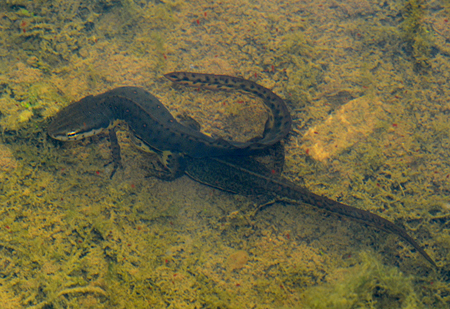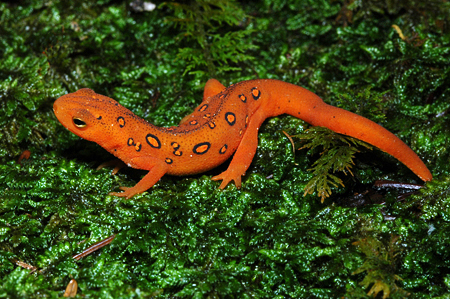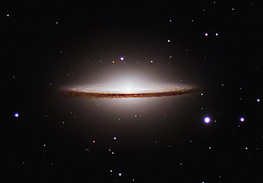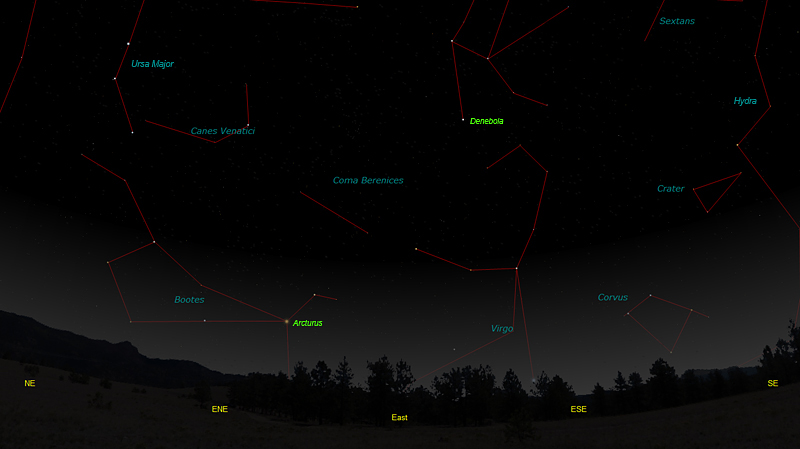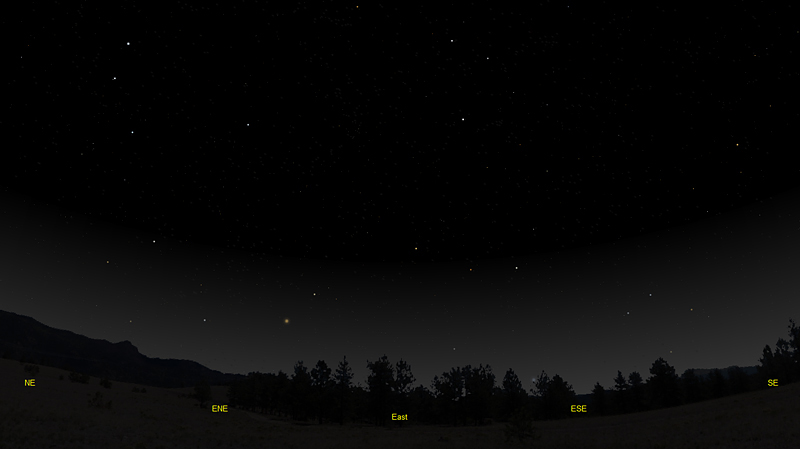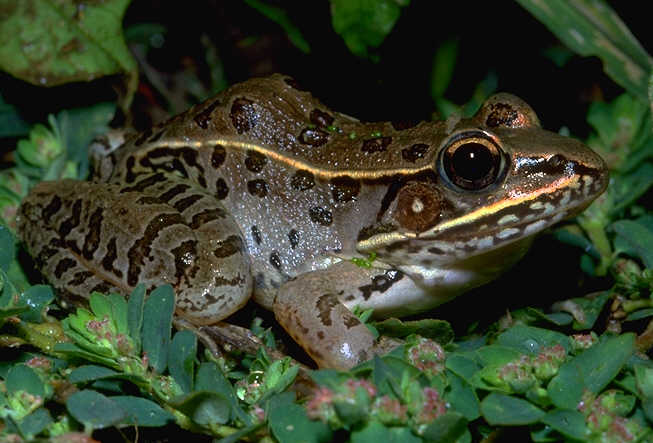The purpose of this feature is to give scout leaders, educators and naturalists an idea of some of the natural events coming up each month. We will try to cover a variety of natural events ranging from sky events to calling periods of amphibians, bird and mammal watching tips, prominent wildflowers and anything else that comes to mind. We will also note prominent constellations appearing over the eastern horizon at mid-evening each month for our area for those who would like to learn the constellations. If you have suggestions for other types of natural information you would like to see added to this calendar, let us know! Note: You can click on the hyperlinks to learn more about some of the featured items. To return to the Calendar, hit the "back" button on your browser, NOT the "back" button on the web page. All charts are available in a "printer friendly" mode, with black stars on a white background. Left clicking on each chart will take you to a printable black and white image. Please note that images on these pages are meant to be displayed at 100%. If your browser zooms into a higher magnification than that, the images may lose quality. Though we link book references to nationwide sources, we encourage you to support your local book store whenever possible. Notes and Images From February 2013
The first day of February brought a dusting of snow to our field. The temperature fell to 18 degrees Fahrenheit, so the snow fell as a fine powder. Though February traditionally brings some of our coldest winter days, it also is a time when many species begin their breeding cycle. At dusk we often hear American Woodcock doing their courtship flights from our field. Early breeding frog species like Upland Chorus Frogs are heard everywhere. We find Tiger Salamander egg masses attached to the cocklebur stems in our pond, and Red-spotted Newts can be seen mating in the shallows. Great Horned Owls are already on their nest by now. Once, while doing a wildlife survey in Springfield, Tennessee in early February, we saw a Red-shouldered Hawk male swoop up and land next to a female on a limb overhead. The two then mated. When imaging Saturn last February, I heard a strange raspy bark coming from the location of a fox den near the corner of our farm. The bark came about once every two seconds. I had seen the body of a fox beside the highway not far from the den the previous week, and when I researched the sound I found it to be the sound of a female fox, a vixen, calling for a mate.
We found these two Red-spotted newts mating in our pond on February 12th. Our Red-spotted Newt is a subspecies of the Eastern Newt, Notophthalmus viridescens. The life cycle of the newt is interesting in that it usually consists of four separate stages; egg, aquatic larva, terrestrial red eft, and aquatic adult. The incubation period for the eggs is from 20 to 35 days, depending on the water temperature. The gilled aquatic larvae feed on small invertebrates. Aquatic larvae that transform to the eft stage (some transfer directly to a gilled adult), do so after 2-5 months. The red eft is a terrestrial stage. The eft leaves the pond and travels to forested habitat, where it forages for invertebrates among the leaf litter. Efts tracked in one study required about one year to migrate 800 meters to a forested area. The eft stage can last from 2 to 7 years. Efts can range in color from brownish to bright orange. Efts in coastal populations are not as brightly colored as those found at higher elevations. The bright color is a warning to potential predators; the skin of efts contains toxins that may be harmful or fatal to small animals. Among the animals said to avoid them are Raccoons, American Toads, Garter Snakes, Killdeers and Red-tailed Hawks. The skin of red efts is said to be more than 10 times more toxic than the skin of adult newts. After 2 to 7 years in a forested habitat, the efts migrate back to the pond from which they came. In doing so they exhibit a remarkable homing instinct. Upon reaching the pond they transform to the adult aquatic form and are ready to start the breeding cycle. Adult male newts have been known to live up to 15 years and females up to 12 years.1 The words eft and newt come from variations on the Old English "efete" and a Middle English variation, "ewte". The phrase "an ewte" became "a newt". 1Information for the above paragraphs taken from Petranka, James W. 1998, Salamanders of the United States and Canada, Smithsonian Institution Press, 587pp.
I made my first attempt of the year to image Saturn in the early morning hours of February 12th, the same day I photographed our mating newts. Somehow, it never gets easier to get up out of bed at 2:30am to take images. On the other hand, Saturn, like the popular kid in high school, never seems to look bad in his pictures. I always get a thrill when the planet appears on my computer screen. Saturn takes about 29-1/2 years to orbit the Sun. Since the plane of its orbit is angled to the Earth's orbital plane, the rings appear to slowly open and close during that time. In the image at right, I've placed the image from last February at the top and the image taken on the 12th at the bottom. This is about the maximum tilt that the rings will reach this year. In future years the ring angle will keep increasing until the rings reach their maximum tilt in 2016.
On February 24th I noticed that the atmospheric "seeing" was predicted to be above average for the early evening hours. I hurriedly assembled and aligned the 20-inch Newtonian and was ready to go before the sky was dark. It was a beautiful night, with a rising moon just shy of being full. The Upland Chorus Frogs at our pond called continuously while I took images. The Great Red Spot is visible on the right hand side of the image at right, as well as the Little Red Spot (also called "Red Junior") at the top left. Oval BA, the official name for Red Junior, dates back to the year 2000, and like its larger relative, is a storm in Jupiter's atmosphere. It originally was a white oval. It turned from white to red in August of 2005.
Sky Events for March 2013: The Vernal Equinox, marking the beginning of Spring in the Northern Hemisphere, occurs at 6:02am CDT on the morning of March 20th.
Comet Pan Starrs (C2011 L4): This comet has faded a bit in its approach to the Sun, but is still expected to reach third magnitude in early March. [Update March 13th - Saw the comet last night! Faint with the naked eye, but binoculars show it well] Look for it low in the western sky about 30 minutes after sunset from March 9th onward. The comet should be visible to the naked eye, a fine binocular target, and a great target for a camera. It will initially be in a bright twilight sky and then will set later as the month progresses. Shown at right is Comet Lulin from 2009. This image is a 7 minute unguided exposure with a 300mm lens. Comet Lulin peaked around 5th magnitude, or about 16 times fainter than Pan Starrs is predicted to be. As with all comets, it pays to get away from the bright lights of the city to observe. Comets deserve to be viewed from clear rural skies. In an essay on comets in Sky and Telescope (July, 1996) Jay Reynolds Freeman said,
Evening Sky: Jupiter continues to shine brightly throughout March. Look for it in Taurus near the bright star Aldebaran. It will be the brightest star-like object in the sky. Binoculars, if held steady, will show the four Galilean moons when they are not transiting the planet or being eclipsed. Saturn rises about 10:20pm on March 1st in Libra. Saturn is approaching opposition on April 27th, and its apparent size is increasing. The rings are open to around 19 degrees, giving a beautiful view of the very dark Cassini's Division. To get the best telescopic views wait till the planet has climbed high above the southern horizon around 3:45am. All times noted in the Sky Events are for Franklin, Tennessee and are Central Standard Time. Constellations: The views below show the sky looking east at 9:30pm CDT on March 15th. The first view shows the sky with the constellation outlines and names depicted. Star and planet names are in green. Constellation names are in blue. The second view shows the same scene without labels. The bright star Arcturus, in Bootes, the Herdsman, makes its appearance this month in the early evening sky, a sure sign that Spring is here. In the southeast, Virgo clears the horizon this month along with Corvus, the Crow. The area of sky encompassing Leo, Virgo and Como Berenices marks the heart of the great Virgo cluster of galaxies. In the early morning hours Virgo will have risen high enough in the sky to search for the many bright galaxies that are in this region. Messier 104, in southern Virgo just above Corvus, is one of the easier galaxies to spot in binoculars. Click the image above to go to a full size image and a binocular finder chart.
On Learning the Constellations: We advise learning a few constellations each month, and then following them through the seasons. Once you associate a particular constellation coming over the eastern horizon at a certain time of year, you may start thinking about it like an old friend, looking forward to its arrival each season. The stars in the evening scene above, for instance, will always be in the same place relative to the horizon at the same time and date each March. Of course, the planets do move slowly through the constellations, but with practice you will learn to identify them from their appearance. In particular, learn the brightest stars (Like Arcturus and Denebola in the above scene looking east), for they will guide you to the fainter stars. Once you can locate the more prominent constellations, you can "branch out" to other constellations around them. It may take you a little while to get a sense of scale, to translate what you see on the computer screen or what you see on the page of a book to what you see in the sky. Look for patterns, like the stars of Corvus the Crow. The earth's rotation causes the constellations to appear to move across the sky just as the sun and the moon appear to do. If you go outside earlier than the time shown on the charts, the constellations will be lower to the eastern horizon. If you observe later, they will have climbed higher. As each season progresses, the earth's motion around the sun causes the constellations to appear a little farther towards the west each night for any given time of night. The westward motion of the constellations is equivalent to two hours per month. Recommended: Sky & Telescope's Pocket Star Atlas is beautiful, compact star atlas. A good book to learn the constellations is Patterns in the Sky, by Hewitt-White. You may also want to check out at H. A. Rey's classic, The Stars, A New Way to See Them. For skywatching tips, an inexpensive good guide is Secrets of Stargazing, by Becky Ramotowski. A good general reference book on astronomy is the Peterson
Field Guide,
A Field Guide to the Stars and Planets, by Pasachoff. The book retails for around $14.00. Starry Night has several software programs for learning the night sky. Visit the Starry Night web site at www.starrynight.com for details. The Virtual Moon Atlas is a terrific way to learn the surface features of the Moon. And it's free software. You can download the Virtual Moon Atlas here. Cartes du Ciel (described in the monthly notes above) is a great program for finding your way around the sky. It is also free, and can be downloaded here. Apps: We really love the Sky Safari 3 Pro application described here. For upcoming events, the Sky Week application is quite nice. Both apps are available for both I-phone and Android operating systems.
Amphibians:
The mild winter has resulted ideal breeding conditions for many species. Upland Chorus Frogs, Southern Leopard Frogs, and Spring Peepers are going strong. American Toads should be calling soon, if they are not already calling where you are. In West Tennessee, Crawfish Frogs continue to give their loud snoring calls early in the month. At higher elevations, listen for Mountain Chorus Frogs. Towards the end of the month listen for Pickerel Frogs doing their "yeeooow" call. Remember that on mild nights you may find frogs and toads out foraging that you do not hear until later in the season. On warm days listen for early treefrogs, like Cope's Gray Treefrog, and for early Northern Cricket Frogs. The Northern Cricket Frogs at our pond often call just before a train passes by our field, possibly stimulated by the vibrations. Recommended: The Frogs and Toads of North America, Lang Elliott, Houghton Mifflin Co.
Archives (Remember to use the back button on your browser, NOT the back button on the web page!) Natural Calendar February 2013 Natural Calendar December 2012 Natural Calendar November 2012 Natural Calendar September 2012 Natural Calendar February 2012 Natural Calendar December 2011 Natural Calendar November 2011 Natural Calendar September 2011 Natural Calendar February 2011 Natural Calendar December 2010 Natural Calendar November 2010 Natural Calendar September 2010 Natural Calendar February 2010 Natural Calendar December 2009 Natural Calendar November 2009 Natural Calendar September 2009 Natural Calendar February 2009 Natural Calendar December 2008 Natural Calendar November 2008 Natural Calendar September 2008 Natural Calendar February 2008 Natural Calendar December 2007 Natural Calendar November 2007 Natural Calendar September 2007 Natural Calendar February 2007 Natural Calendar December 2006 Natural Calendar November 2006 Natural Calendar September 2006 Natural Calendar February 2006
Natural Calendar
December 2005
Natural Calendar
November 2005
Natural Calendar
September 2005
Natural Calendar
February 2005
Natural Calendar
December 2004
Natural Calendar
November 2004
Natural Calendar
September 2004
Natural Calendar
February 2004
Natural Calendar
December 2003
Natural Calendar
November 2003
Natural Calendar
September 2003 Natural Calendar February 2003 Natural Calendar December 2002 Natural Calendar November 2002 Nature Notes Archives: Nature Notes was a page we published in 2001 and 2002 containing our observations about everything from the northern lights display of November 2001 to frog and salamander egg masses. Night scenes prepared with The Sky Professional from Software Bisque All images and recordings © 2013 Leaps |
||||||||||||||||

